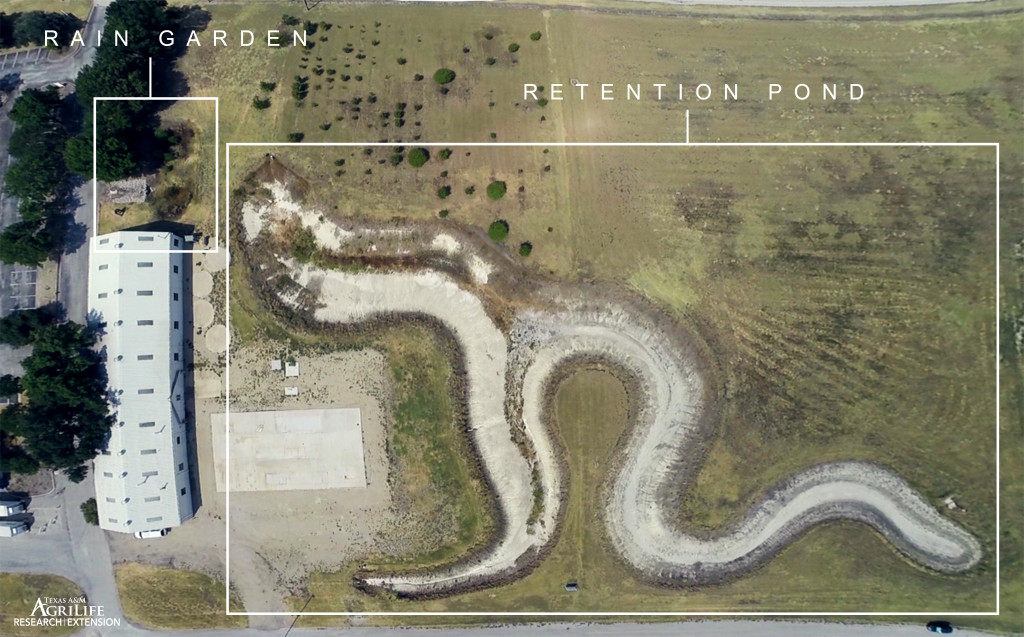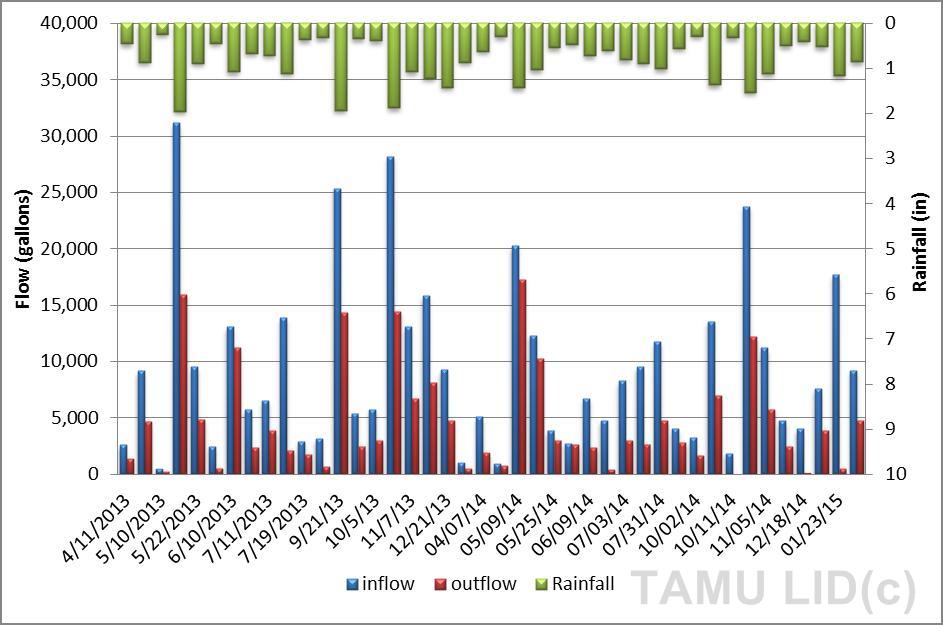The Upper Trinity River that drains the DFW metroplex has been designated impaired for chlordane (TCEQ 2008) and bacteria (TCEQ 2010). In addition, total phosphorus, nitrate, chlorophyll-a, and orthophosphate are considered parameters of concern (TCEQ 2010). These water quality impairments underscore the need to evaluate stormwater management in this area.
Low impact development (LID) is considered to be a way to mitigate the adverse effects of increasing impervious cover, using decentralized measures to retain stormwater runoff on-site, and thereby seeking to mimic the natural pre-development hydrology of a site. Also known as green infrastructure, LID includes structural practices such as bioretention, green roofs, rainwater harvesting, and permeable pavements, as well as non-structural practices such as elimination of curbs and gutters, disconnecting downspouts from stormwater conveyance, strategic grading, and utilizing native vegetation (Ahiablame et al. 2012). The primary goals of LID best management practices include reduction of runoff peak flow rate and volume, increasing infiltration and groundwater recharge, reducing stream bank erosion as well as removing pollutants by processes such as filtration, chemical absorption and biological degradation.

Combined aerial view of the Rain Garden and Retention Pond at the Dallas Urban Center. (Click to Enlarge all Photos)
Rain Garden
Bioretention areas or rain gardens are designed to be a depressed area in a landscape that receives and attenuates stormwater (USEPA 2006). They use the chemical, biological and physical properties of soils, flora and microorganisms to remove or retain pollutants from stormwater (Hinman, 2005). Typically, these areas consist of a soil mixture planted with native or adapted plants that receive stormwater from a small contributing area (Davis, 2008). Bioretention areas promote infiltration, storage and slow release of water (Hinman, 2005). The capacity of bioretention systems to reduce stormwater volume and peak flow rate, in the rage of 40% to 97% has been well documented. The reductions depend on the magnitude of rainfall, with all the runoff from small events being completely captured by these structures (Davis, 2008). However, there exists a need for region specific data, as a large variation has been shown in the reduction capacity of these bioretention areas (Dietz, 2007). In addition, the local nature of the plant and soil material underscores the need for a regional (Texas) evaluation of bioretention systems.
A bioretention area (rain garden) was constructed on the premises of Texas A&M AgriLife Research and Extension Center in Dallas. The bioretention collects runoff from around 36,000 square feet of the parking lot (Figure 3) Curb cuts allow for runoff to drain to a forebay, which is a hundred square feet in area and about one foot deep on average for automatic sampling (ISCO 6712) and flow measurement (flume and bubbler flow meter). Runoff is directed into the bioretention area (100ft x 20 ft). All runoff in the rain garden watershed is routed through the inlet flume. A surface overflow box drains water to an underground pipe to the first inlet of the detention pond. Additionally, the drainage layer of the rain garden houses a perforated pipe that assists with soil infiltration. The underdrain was elevated using a 90 degree elbow, to create an internal water storage (IWS) layer. Use of IWS increases water storage and creates an anaerobic zone that is conducive to denitrification (Brown et al, 2012).
| Pollutant | Inflow | Outflow | % Reduction |
| NO3 (mg) | 45,476 | 13,804 | 70% |
| Orthophosphate (mg) | 10,351 | 565 | 95% |
| TSS (mg) | 3,214,417 | 307,276 | 90% |
| E. coli (cfu) | 31,855,184 | 11,489,962 | 64% |
Average loads and reduction rate for the Bioretention area during the project period (2013-2015)
The bioretention data showed that runoff volume was reduced by 49% with the majority of the flow coming out as drainage from the perforated pipe. This runoff from the perforated pipe was treated through the bioretention system even if it left the bioretention as drainage. The data shows pollutant reduction rates of 70% for nitrate, 95% for orthophosphate, 90% for total suspended solids and 65% for bacteria. The bioretention provided the highest treatments other than the detention pond and had the highest treatment area/watershed area of all treatments.
Detention Pond
Detention ponds are basins that are designed to hold run off from the surrounding area till it infiltrates into the ground. In certain soil and weather conditions, detention ponds can be modified to act similarly as LID structures where it would be designed to retain a portion of the runoff, in addition to the water quality benefits and the peak flow reduction.
An ISCO flow meter was used to measure the overflow and perforated pipe flow and samples were collected with an ISCO 3700 automatic sampler. The outlet for the rain garden acts as one of the inlets for a detention pond constructed on campus, making the rain garden a pre-treatment for the detention pond BMP. The structure and placement of the flow meter that measures the combined outflow creates turbulence and ensures adequate mixing before the runoff is collected by the automatic samplers.
The detention pond was designed to retain 1.5 inches of runoff and collect inflow/outflow and water quality data. The pond was designed to resemble a meandering river with two inflow points, planted with associated vegetation to reduce erosion as well as act as filter strips, to serve as a demonstration tool for stream restoration. The width to length ratio was also taken into consideration to maximize sediment retention and nutrient uptake. The detention pond has two inlet points, and most of the impervious part of the Texas AgriLife campus (6 acres) runoff (Figure 11) was routed to the pond via the two inlet flumes (Figure 12). One of the inlets of the detention pond is the outlet of the rain garden BMP.
The detention pond collected runoff from 45% (which included most of the impervious surfaces of the built up watershed (440,248 sq. ft.) of the Texas A&M AgriLife campus (excluding agricultural research fields). In addition to the 165,000 square feet of watershed feeding the east branch of the pond includes a large portion of the buildings (green polygon); the pond collects the outflow from the rain garden (36,000 sq.ft/ red polygon).
| Pollutant | Inflow |
| NO3 | 1,233,489 |
| Orthophosphate | 61,119 |
| TSS | 8,840,010 |
| E. coli (cfu) | 516,732,180 |
Total load(mg) in the inflow into the detention pond during the project period.
From February 2015 to the end of May 2015, flow was reduced by 62%, nitrate by 91%, TSS by 18%, and E. coli by 81%. No orthophosphate was found in the inflow or outflow during that period.


